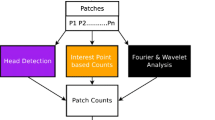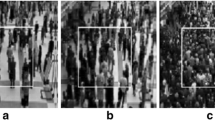Abstract
Crowd density estimation is a challenging research problem in computer vision and has many applications in commercial and defense sectors. Various crowd density estimation methods have been proposed by researchers in the past, but there is an utmost need for accurate, robust and efficient crowd density estimation techniques for its practical implementation. In this paper, we propose a fine-tuned and computationally economical, ensemble regression-based machine learning model for crowd density estimation. The WorldExpo’10 dataset has been used for experimental analysis and model performance evaluation. We extract variety of features in texture-based features such as gray-level co-occurrence matrix, local binary pattern and histogram of oriented gradients, structure-based features such as perimeter pixel and the orientation of pixels, and segment-based handcrafted features from each patch of the image and use an optimum combination of these features as input to the regression model. To achieve optimized memory utilization and faster speed, principal component analysis is employed to reduce the dimensions of the lengthy feature vector. Extensive experiments on different fronts ranging from the model hyperparameter optimization, features optimization and features selection were conducted, and at each step, we selected the most favorable results as input to the optimized model. The performance of the model is evaluated based on two popular metrics, i.e., mean absolute error and mean squared error. The comparative analysis shows that the proposed system outperforms the former methods tested on the WorldExpo’10 dataset.






Similar content being viewed by others
Explore related subjects
Discover the latest articles and news from researchers in related subjects, suggested using machine learning.References
Zhang C, Li H, Wang X, Yang X (2015) Cross-scene crowd counting via deep convolutional neural networks. In: Proc IEEE comput soc conf comput vis pattern recognit, 07–12 June, pp 833–841. https://doi.org/10.1109/CVPR.2015.7298684
Chen K, Loy CC, Gong S, Xiang T (2012) Feature mining for localised crowd counting. In: Proceedings Br mach vis conf 2012, vol 1, pp 1–11. https://doi.org/10.5244/C.26.21
Ryan D, Denman S, Fookes C, Sridharan S (2009) Crowd counting using multiple local features. In: DICTA 2009—digit image comput tech appl, pp 81–88. https://doi.org/10.1109/DICTA.2009.22
Ma W, Huang L, Liu C (2010) Crowd density analysis using co-occurrence texture features. In: Proceeding—5th int conf comput sci converg inf technol ICCIT 2010, pp 170–175. https://doi.org/10.1109/ICCIT.2010.5711051
Idrees H, Saleemi I, Seibert C, Shah M (2013) Multi-source multi-scale counting in extremely dense crowd images. In: Proc IEEE comput soc conf comput vis pattern recognit, pp 2547–2554. https://doi.org/10.1109/CVPR.2013.329
Chan AB, Liang ZSJ, Vasconcelos N (2008) Privacy preserving crowd monitoring: Counting people without people models or tracking. In: 26th IEEE conference on computer vision and pattern recognition, CVPR, pp 1–7
Gao C, Li P, Zhang Y et al (2016) People counting based on head detection combining Adaboost and CNN in crowded surveillance environment. Neurocomputing 208:108–116. https://doi.org/10.1016/j.neucom.2016.01.097
Loy CC, Chen K, Gong S, Xiang T (2013) Crowd counting and profiling: methodology and evaluation. In: Ali S, Nishino K, Manocha D, Shah M (eds) Modeling, simulation and visual analysis of crowds. Springer, New York. https://books.google.com.pk/books?id=Ajm3BAAAQBAJ&pg=PA347&lpg=PA347&dq=Crowd+counting+and+profiling:+methodology+and+evaluation&source=bl&ots=Odoup9uMJI&sig=EKLnSdh84JHfHdozaRSd9abxTuo&hl=en&sa=X&ved=2ahUKEwiovvGU6uzfAhVHKqwKHV9MD_oQ6AEwB3oECAMQAQ#v=onepage&q=Crowd%20counting%20and%20profiling%3A%20methodology%20and%20evaluation&f=false
Wang Y, Lian H, Chen P, Lu Z (2014) Counting people with support vector regression. In: 2014 10th int conf nat comput ICNC 2014, pp 139–143. https://doi.org/10.1109/ICNC.2014.6975824
Nanni L, Brahnam S, Ghidoni S, Menegatti E (2013) Automated crowd detection in stadium arenas. In: Northeast decis sci inst annu meet proc, p 10
Xu B, Qiu G (2016) Crowd density estimation based on rich features and random projection forest. In: 2016 IEEE winter conf appl comput vision, WACV 2016. https://doi.org/10.1109/WACV.2016.7477682
Hanif MS, Ahmad S, Khurshid K (2017) On the improvement of foreground–background model-based object tracker. IET Comput Vis 11:488–496. https://doi.org/10.1049/iet-cvi.2016.0487
Ali N, Bajwa KB, Sablatnig R, Mehmood Z (2016) Image retrieval by addition of spatial information based on histograms of triangular regions. Comput Electr Eng 54:539–550. https://doi.org/10.1016/j.compeleceng.2016.04.002
Sharif U, Mehmood Z, Mahmood T et al (2018) Scene analysis and search using local features and support vector machine for effective content-based image retrieval. Artif Intell Rev. https://doi.org/10.1007/s10462-018-9636-0
Mehmood Z, Gul N, Altaf M et al (2018) Scene search based on the adapted triangular regions and soft clustering to improve the effectiveness of the visual-bag-of-words model. Eurasip J Image Video Process. https://doi.org/10.1186/s13640-018-0285-7
Chan AB, Morrow M, Vasconcelos N (2009) Analysis of crowded scenes using holistic properties. IEEE Trans Signal Process 50:174–188. https://doi.org/10.1109/78.978374
Chan AB, Vasconcelos N (2012) Counting people with low-level features and bayesian regression. IEEE Trans Image Process 21:2160–2177. https://doi.org/10.1109/TIP.2011.2172800
Bansal A, Venkatesh KS (2015) People counting in high density crowds from still images. Comput Vis Pattern Recognit. https://doi.org/10.17706/IJCEE.2015.7.5.316-324
Saunders C, Gammerman A, Vovk V (1998) Ridge regression learning algorithm in dual variables. In: Proc 15th int conf mach learn, pp 515–521. https://doi.org/10.1111/j.0033-0124.1985.00197.x
Wu X, Liang G, Lee KK, Xu Y (2006) Crowd density estimation using texture analysis and learning. In: 2006 IEEE int conf robot biomimetics, pp 214–219. https://doi.org/10.1109/ROBIO.2006.340379
Sarwar A, Mehmood Z, Saba T et al (2018) A novel method for content-based image retrieval to improve the effectiveness of the bag-of-words model using a support vector machine. J Inf Sci. https://doi.org/10.1177/0165551518782825
Khan MJ, Yousaf A, Abbas A, Khurshid K (2018) Deep learning for automated forgery detection in hyperspectral document images. J Electron Imaging 27:1. https://doi.org/10.1117/1.JEI.27.5.053001
Khan MJ, Yousaf A, Javed N et al (2017) Automatic target detection in satellite images using deep learning. J Space Technol 7:44–49
Yousaf A, Khan MJ, Imran M, Khurshid K (2017) Benchmark dataset for offline handwritten character recognition. In: 2017 13th international conference on emerging technologies (ICET)
Khan MJ, Yousaf A, Khurshid K et al (2018) Automated forgery detection in multispectral document images using fuzzy clustering. In: 13th IAPR international workshop on document analysis systems. IEEE, Vienna
Khan MJ, Khan HS, Yousaf A et al (2018) Modern trends in hyperspectral image analysis: a review. IEEE Access 6:14118–14129. https://doi.org/10.1109/ACCESS.2018.2812999
Charan S, Khan MJ, Khurshid K (2018) Breast cancer detection in mammograms using convolutional neural network. In: 2018 International conference on computing, mathematics and engineering technologies (iCoMET). IEEE, pp 1–5
Wang C, Zhang H, Yang L et al (2015) Deep people counting in extremely dense crowds. In: MM’15 proc 23rd ACM int conf multimed, pp 1299–1302. https://doi.org/10.1145/2733373.2806337
Haralick R, Shanmugan K, Dinstein I (1973) Textural features for image classification. IEEE Trans Syst Man Cybern 3:610–621
Pietikäinen M (2010) Local binary patterns. Scholarpedia 5:9775
Dalal N, Triggs B (2005) Histograms of oriented gradients for human detection. In: Proceedings—2005 IEEE computer society conference on computer vision and pattern recognition, CVPR 2005, pp 886–893
Mehmood Z, Anwar SM, Ali N et al (2016) A novel image retrieval based on a combination of local and global histograms of visual words. Math Probl Eng. https://doi.org/10.1155/2016/8217250
Mehmood Z, Mahmood T, Javid MA (2018) Content-based image retrieval and semantic automatic image annotation based on the weighted average of triangular histograms using support vector machine. Appl Intell 48:166–181. https://doi.org/10.1007/s10489-017-0957-5
Mehmood Z, Anwar SM, Altaf M (2018) A novel image retrieval based on rectangular spatial histograms of visual words. Kuwait J Sci 45:54–69
Breiman L (1996) Bias, variance, and arcing classifiers. Tech Rep 460, April 1996
Friedman JH (2001) Greedy function approximation: a gradient boosting machine. Ann Stat 29:1189–1232. https://doi.org/10.1214/aos/1013203451
Author information
Authors and Affiliations
Corresponding author
Ethics declarations
Conflict of interest
The authors declare that they have no conflict of interest.
Additional information
Publisher's Note
Springer Nature remains neutral with regard to jurisdictional claims in published maps and institutional affiliations.
Rights and permissions
About this article
Cite this article
Saleem, M.S., Khan, M.J., Khurshid, K. et al. Crowd density estimation in still images using multiple local features and boosting regression ensemble. Neural Comput & Applic 32, 16445–16454 (2020). https://doi.org/10.1007/s00521-019-04021-2
Received:
Accepted:
Published:
Issue Date:
DOI: https://doi.org/10.1007/s00521-019-04021-2




